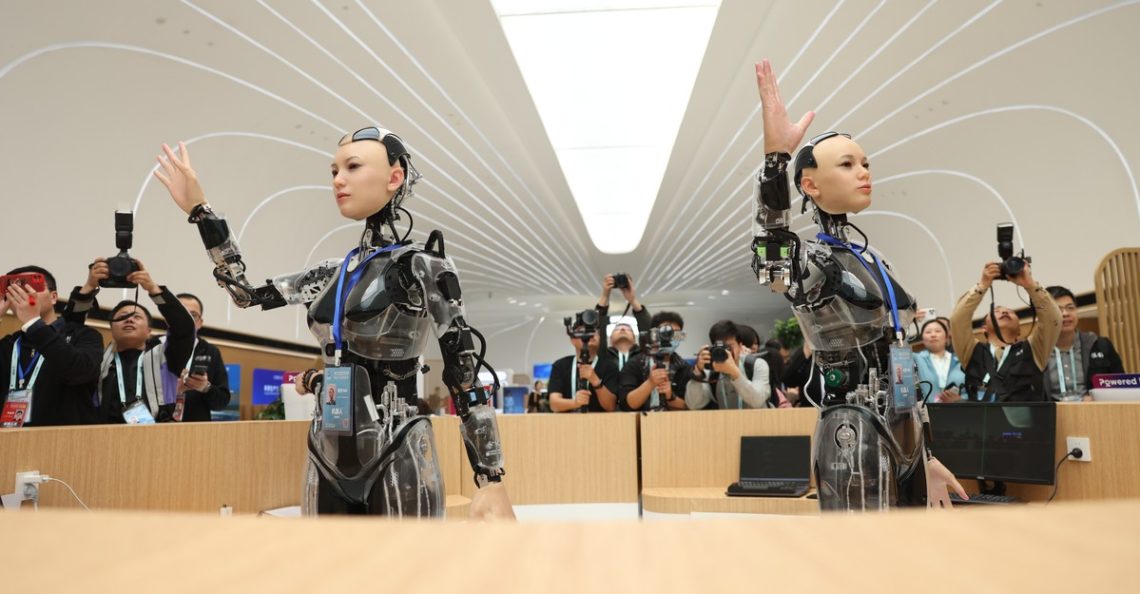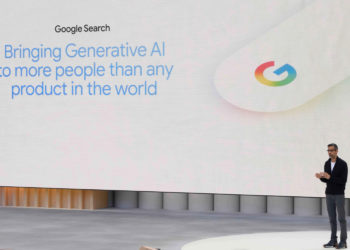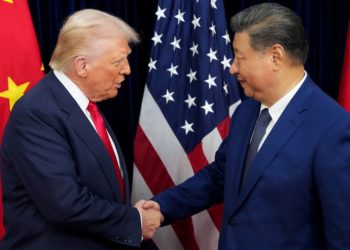After a months-long trade war between China and the United States, Presidents Donald Trump and Xi Jinping are scheduled to meet Thursday in Korea. Both countries seem to be angling for a truce; over the weekend, they announced a “framework” for a possible agreement.
The negotiations offer an occasion to stop to consider how China went from technological backwater to superpower in less than half a lifetime, and an opportunity for the United States to learn from that success. U.S. companies can work to regain hardware-manufacturing expertise, absorb knowledge and talent from some of China’s best companies, and shift their approach toward AI, encouraging more practical applications and open-source innovation. The United States must accept that we can be better while not relinquishing our strengths.
If America focuses only on undermining its rival, it risks stagnating, and China might end up offering a more attractive vision of the future to the rest of the world than the United States can. What’s at stake is America’s ability to keep innovating and leading in the industries of the future.
In 1896, Li Hongzhang, a diplomat from imperial China, arrived in the United States for the first time. China, then under Qing dynasty rule, had yet to fully undergo the Industrial Revolution. The year before, the Chinese had suffered a humiliating defeat in the First Sino-Japanese War, and the country painfully awoke to its own backwardness. Li was stunned by New York City’s tall buildings, rising 20 stories or more, and remarked to American reporters that he had “never seen anything like them before.” He told them: “You are the most inventive people in the world.”
Nearly a century later, in 1988, Wang Huning—then a Fudan University professor and now the fourth-most-powerful man on China’s politburo—visited the United States and experienced a similar “future shock.” After the chaos of the Cultural Revolution, Communist China’s GDP was a mere 6 percent of America’s. During his six months in the United States, Wang marveled at the Gateway Arch in St. Louis, credit cards, computers, the Discovery space shuttle, and research universities such as MIT. “If the Americans are to be overtaken,” he later wrote, “one thing must be done: surpass them in science and technology.”
These days, it’s the foreigners visiting China who often experience future shock, astonished by the towering skyscrapers, high-speed rail, megabridges, and ubiquitous electric cars, super-apps, and trifold smartphones. China has become an innovation powerhouse. The country now accounts for 70 percent of the world’s granted AI patents, 75 percent of global patent applications in clean-energy technology, 41 percent of granted patents in the life sciences and biotechnology, and more patent applications in fusion technology than any other country. Eight of the world’s top 10 institutions by research output are in China, according to the Nature Index. China is debuting not just pilotless flying taxis but also legions of robots, the Tiangong space station, the world’s largest hydropower project, a leading hypersonic-weapons arsenal, and more. Standing on its streets, as we did on a visit this past July, one can feel the country’s intense desire to leapfrog into the future.
Of course, China’s economic success has not been accompanied by political liberalization—as some expected when it joined the World Trade Organization. The United States became the world’s superpower because of its openness, dynamism, and embrace of capitalism and democracy. American companies have thrived in a free market and under an independent judiciary, with state power diffused among various levels and branches of government. China, meanwhile, has adopted a “state capitalist” system that puts stability ahead of individual freedoms and gives the Chinese Communist Party economic control. That has led to chronic overregulation, which in turn has chilled investment, battered profits, and driven high-profile entrepreneurs out of public view. The Chinese economy, which is still smaller than the U.S. economy, is now battling overcapacity, a prolonged property slump, soaring youth unemployment, and weak domestic consumption.
Yet China has proved surprisingly resilient in the face of these headwinds, amid narratives about its decline. China is the world’s top manufacturer and exporter. It produces more than two-thirds of electric vehicles globally, four in five solar modules and battery cells, and about 60 percent of the planet’s wind turbines, and it processes the great majority of rare-earth minerals, which are crucial for creating technologies as varied as chips and fighter jets. Even as its economy slows, China has continued to make significant technological advances.
The experience of visiting a Xiaomi store is like walking into a supermarket for high-tech gadgets. The first thing you see is the company’s latest YU7 electric sport utility vehicle (which was ordered 289,000 times within an hour of going on sale). White-veneer tables display smartphones and tablets. Then comes an array of smart appliances that can be managed on a phone: rice cookers, robot vacuum cleaners, air purifiers, TVs, and even dumbbells.
When Xiaomi was founded, in 2010, many people derided it as an Apple copycat. Today Xiaomi is one of China’s most valuable companies, with a market value of about $150 billion. It’s become a cult brand for Gen Z consumers who fill their homes with its products, and was one of the first tech giants in the world to actually manufacture a car. Xiaomi launched its first EV in 2024, just three years after its founder, Lei Jun, had publicly claimed that making cars would be his “last entrepreneurial project.” One month before the launch, Apple had announced that it was shutting down its own project to build an EV, which had soaked up $10 billion over the course of a decade.
Xiaomi’s success reflects a distinctive characteristic of many Chinese tech companies: They build their own hardware. Xiaomi can more easily invent new products, because those products can be quickly prototyped, refined, and shipped at scale. The company has invested in some 430 companies; many of them are other hardware start-ups that offer their own manufacturing expertise, including in the core components of EVs—batteries, chargers, lidars, sensors. Xiaomi also built a highly automated factory that the company says can produce a car, the SU7 model, every 76 seconds.
Xiaomi’s success has also been possible because of suppliers, infrastructure, and technical expertise that already existed in China. In China, electricity is cheap, construction happens quickly, and the workforce is skilled across various physical technologies. In a matter of a decade, China has installed nearly half of the industrial robots in the world, more than 70 percent of the world’s total high-speed rail, more than half of the world’s 5G base stations, and an electricity system that has more than double the generating capacity of the United States.
Xiaomi isn’t unique. Huawei has expanded from building telecom equipment and phones to supplying car parts. Alibaba, the e-commerce giant, is now developing inference chips for its Qwen series of AI models. XPeng, a carmaker, is starting to test humanoid robots. Not all of these ventures will succeed, but the expertise they cultivate among workers, and the supply chain they put in place, can be transferred to the next industry of the future.
The United States stands to benefit from Chinese companies’ hardware-manufacturing expertise. If Americans want to bring back manufacturing to the country, we need to think of ways to absorb the Chinese talent and firms that want to enter our market and build on our shores.
The buzzword of the year in China is involution, which refers to excessive competition with ever-slimmer profit margins. As a glut of companies has competed domestically, price wars have afflicted food-delivery giants, electric carmakers, solar-panel manufacturers, and even AI-chatbot makers. When we attended the World AI Conference in Shanghai this summer, every company we encountered wanted to expand overseas, including into the United States. But the only path that many Chinese founders see is to keep grinding to compete domestically. In September, Xi acknowledged that involution is a problem. The Chinese government has urged companies to enhance their competitiveness through innovation and quality, rather than price-cutting.
Much of the competition in China is engendered by the way that the post-reform economy is set up. In China, provincial and municipal governments work like venture capitalists, trying to lure entrepreneurs to their jurisdictions with preferential policies and tax subsidies. The latest poster child is Hangzhou with its “Six Little Dragons”—a group of tech companies that includes start-ups such as the robot-maker Unitree and a Neuralink competitor named BrainCo, as well as the AI company DeepSeek. Other local governments, such as Guangdong and Shandong, are trying to emulate Hangzhou, which has business-friendly policies and a strong university.
Competition has its drawbacks, but it has encouraged Chinese companies to differentiate, and helped to diversify the tech sector in China. When it comes to AI, China is pursuing more than just the scaling of large language models (in part due to an insufficient supply of advanced chips under U.S. export controls). DeepSeek, for one, has led the way in improving the efficiency of the technical architecture of its AI models, dramatically reducing costs. Many start-ups are focused on embodied AIs that interact with the real world. Others are specializing in sector-specific applications for AI, such as elderly care and police patrol. Meanwhile, research institutes are exploring alternatives to neural networks (models that emphasize learning by ingesting reams of data and recognizing patterns), including cognitive architectures that can reason with only small amounts of data.
Competition has also spurred companies and local governments to adopt AI as quickly as possible. By some estimates, at least 72 provincial and municipal authorities in China have deployed DeepSeek in their daily operations and in providing public services. Hospitals, EV companies, and home-appliance brands have raced to integrate the newest AI models. In August, China’s State Council issued a set of guidelines to local governments about how to implement the national “AI+” initiative, which aims to embed AI across sectors.
The United States doesn’t want excessive domestic competition like China has. But it can take a cue from China’s diversified approach to AI, and to technology generally. Integrating the AI that’s already available into traditional and emerging industries will allow more people to experience the benefits of the technology. The United States should also encourage more unexpected, creative, and practical uses of AI, including in science, education, and health care.
The southern coastal city of Shenzhen, a sleepy fishing village turned bustling, high-tech metropolis, is emblematic of China’s opening up since the 1980s. In February, one of us visited the district of Huaqiangbei in Shenzhen, home to the world’s largest electronics wholesale market, a cluster of multistory malls and open-air street markets with stalls selling every imaginable electronics part. There’s a joke that every lost phone in the world ends up in Huaqiangbei.
Not long ago, Huaqiangbei was closely associated with the term shanzhai, often used to refer to cheap, low-quality counterfeit and copycat products—for example, iPhone lookalikes running Android operating systems. But as more and more electronics were manufactured in Huaqiangbei, thousands of small-scale factories, design houses, and electronics sellers cropped up and figured out how to develop, manufacture, and ship new products at astonishing speeds. Huaqiangbei’s bottom-up, porous manufacturing ecosystem eventually gave birth to some of China’s biggest tech giants, including Huawei and DJI. Compared with just a decade and a half ago, many more stalls in Huaqiangbei now sell domestic brands, as well as more interesting creations—LED backpacks, dancing mini-robots, wearable surveillance cameras.
Today, with so many innovations emerging from Chinese companies, the term shanzhai seems to have lost its relevance.
At the same time, the idea of open-sourcing is very much alive in China’s AI industry, and that has been a boon for China. Chinese companies regularly release information about the weights and training methods used to create AI models—essentially allowing users to download, modify, and adapt a model for free. (Weights are the numerical values that determine how much an AI should consider certain inputs over others.) When DeepSeek debuted, earlier this year, what was shocking was not just that a Chinese model had come close to American models, but that DeepSeek made its weights public. In the months since, China has seen a flurry of open-source AI models released from large companies—Alibaba, ByteDance, Baidu—as well as start-ups—Minimax, Moonshot AI, StepFun, and Z.ai.
Soon, Chinese AI could become the norm for many parts of the world, especially the global South, in turn attracting more developers to China, increasing the competitiveness of Chinese technologies, and allowing China to shape global technological standards. This will be more consequential than the Belt and Road Initiative, through which China has doled out billions of dollars in infrastructure spending around the world. The Chinese government seems to recognize the power of open-source AI. The AI+ guidelines have a section on open-sourcing that calls for “tools with global reach and influence,” and encourages universities to recognize open-source contributions as degree credits and reward contributions by faculty. We expect China to support the open-source approach in other technology sectors too.
Democratizing access to knowledge has traditionally been a major role of U.S. universities and research labs. Western open-source software has long driven innovation, including in programming languages and web browsers. U.S. tech companies should commit to staying open—collaborating with countries that want to use American technology, and open-sourcing more models and research.
In the 1980s and ’90s, China flung open its doors for foreign firms to invest and set up production, in many cases through joint ventures; the foreign side provided the capital, technology, and export distribution, and the Chinese side opened and staffed the factories. Over time, these companies—including earlier entrants such as General Motors and Johnson & Johnson and relative newcomers such as Tesla—helped transform China into the world’s mightiest factory.
After years of learning from the West, China has become the most formidable technological peer that the United States has faced since the Cold War. In 1957, the Soviet Union’s launch of the Sputnik satellite spurred scientific education and research in the United States. Congress created NASA and expanded science funding in schools to stay competitive. And it worked. The United States should be similarly spurred by China’s technological prowess today.
If the United States really wants to reindustrialize, it needs to double down on what it does best, including supporting scientific research, enacting immigration policies that welcome the best talent from abroad, and reducing regulatory hurdles. But the U.S. tech sector also needs to acknowledge where it can do better, specifically when it comes to hardware expertise, the diversity of the AI industry, and the embracing of an open-source approach to tech.
The United States and China will and should continue to compete. But in specific areas, they would benefit from more cooperation. If the United States wants to revive and expand its manufacturing sector, especially when it comes to batteries, automotive parts, and renewables, part of a potential trade deal should allow Chinese companies to license their IP to U.S. businesses. This would allow Chinese companies to train American workers, create more jobs, and in turn bring back advanced manufacturing to the U.S. Chinese companies such as CATL have expressed a willingness to build American plants if allowed to by the Trump administration. The United States could even require Chinese firms to establish joint ventures with domestic firms. Of course, the United States shouldn’t ignore national-security concerns, but it will have to weigh the need to reduce exposure to China with the need to stay competitive.
If the United States succumbs to hubris or animosity and refuses to see what China has done well, America could end up a more insular, protectionist nation, stuck with expensive made-in-America gadgets, high electricity prices, and diminished universities. And we might no longer be the world’s preeminent superpower.
The post What the U.S. Can Learn From China’s Technological Success appeared first on The Atlantic.




